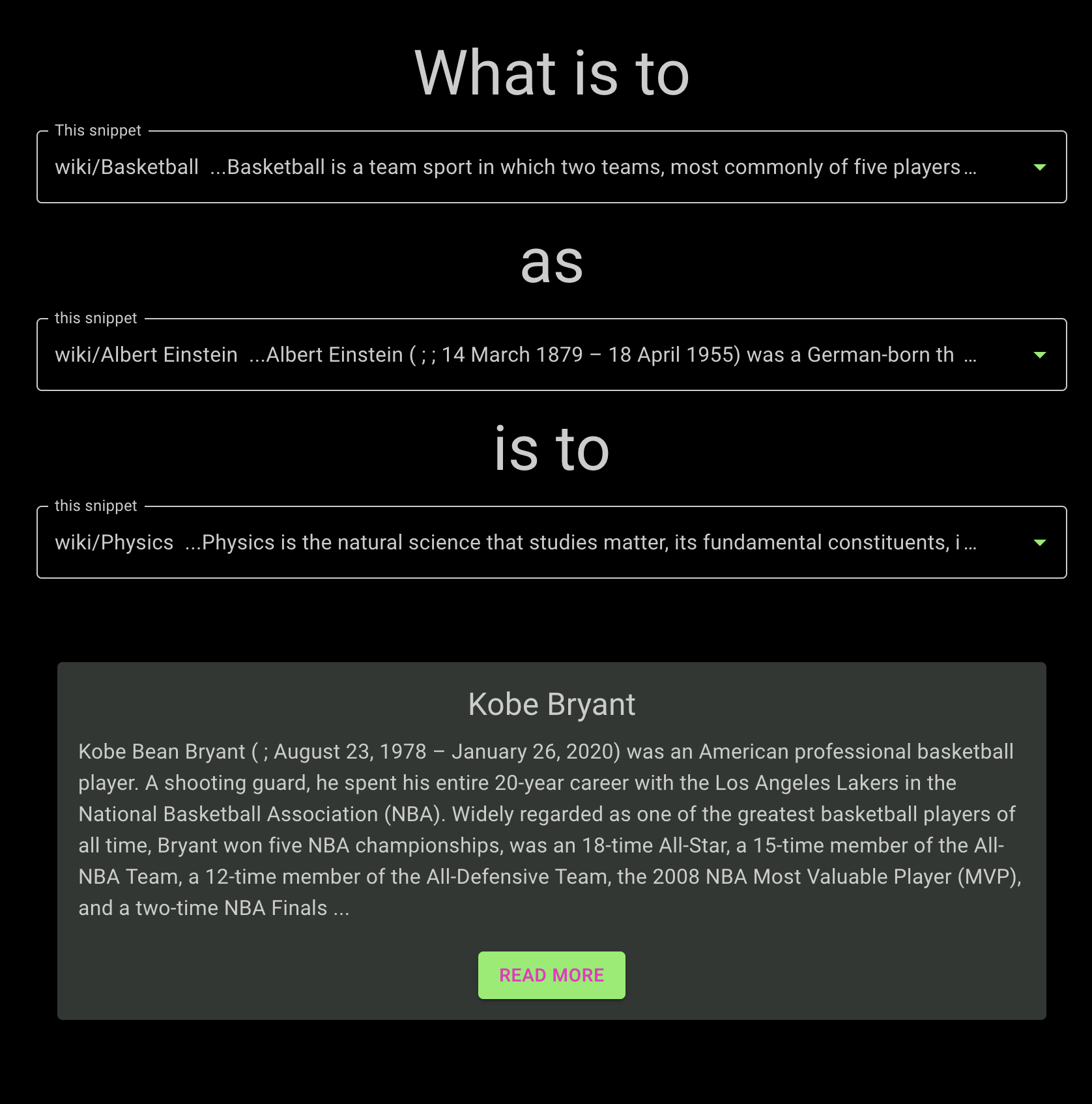This sample project demonstrates the powerful combo of serverless infrastructure from Modal and the search capabilities of Weaviate for projects that combine data-intensive Python compute, like neural network inference, with data-intensive search, like indexing all of Wikipedia.
You can find the code on GitHub here. It's intended as a jumping off point for your own code that combines Modal with databases like Weaviate and with JavaScript frontends. It is also deployed as a live demo application.
The frontend
of this project (written in React, hosted on Vercel)
allows users to construct "vector analogies" of the form made famous by Word2Vec.
For example, the approximation
Albert Einstein - Physics + Basketball ~= Kobe Bryant
expresses the analogy "Kobe Bryant is the Albert Einstein of basketball".
We can compute it by applying those operations to embedding vectors of each concept,
where ~= is implemented using an
approximate nearest-neighbor search index,
the key method used for querying in vector databases.
Where Word2Vec used word embeddings to express concepts, we use snippets of Wikipedia articles. The dataset used was constructed from the March 2022 WikiMedia dump by Hugging Face.
Users can type into each search bar to find a snippet of interest, using Weaviate text search under the hood, and once they've selected the three components of their analogy, the frontend kicks off a vector search to complete it.
Both searches are coordinated by a backend Python service running on Modal.
Modal is also used to construct embeddings for snippets and then insert them into Weaviate. You can read more about the embedding process here. We also wrote a high level guide to this project here.
The full, end-to-end version of this project involves a number of services and workflows:
- A Vite/React frontend, to allow users to search for Wikipedia snippets and construct analogies via vector search
- A Weaviate database on Weaviate Cloud Services, to store the Wikipedia snippets and their embeddings and to run both text and vector searches
- A serverless Weaviate database client on Modal, to listen for requests from app clients, run the search logic, and communicate with the database
- A vector embedding service on Modal serverless GPUs, to embed the Wikipedia snippets as vectors
- An ingestion workflow on Modal, to download the Wikipedia dataset, embed it, and send the results to Weaviate
To make setup easier, we make it possible to run the search via a read-only client of our Weaviate database and run the app locally, which lets you skip the vector embedding and ingestion steps.
Set up a Python environment however you like and then install modal with
pip install modal==0.62.140Because Modal runs all of your code in cloud containers, you don't have to worry about any other dependencies!
If you don't already have a Modal account, get started with
modal setup.
Next, we set up a Weaviate client on Modal that reads from a Weaviate database that has already ingested and indexed the Wikipedia data.
Add WCS_URL=https://gzimzbmdr6ycxyja715rsa.c0.us-west4.gcp.weaviate.cloud and WCS_RO_KEY=tUeQG12AkFLBY9SYOWVh2y00hZ25yu8va0UP to a modal.Secret called wiki-weaviate.
Then, run the following command from the repo root to create a database client on Modal.
modal deploy backend.databaseThis client is serverless, meaning it scales automatically with load, including scaling down to zero instances when there is no load. That means you only need to pay for the compute resources you use!
You can run queries against the database from your local machine to test the client logic, for example
modal run backend.database::WeaviateClient.query --q='Albert Einstein'or you can hit the API directly from your browser or with a tool like curl or Postman.
curl https://modal-labs--modal-weaviate-query.modal.run\?q\=Albert%20EinsteinNote that you should replace modal-labs in the URL with your Modal username!
This will return a large JSON object with a big vector of floating point numbers attached,
so you might want to pipe it through jq or another JSON formatter:
curl https://modal-labs--modal-weaviate-query.modal.run\?q\=Albert%20Einstein \
| jq . results\[0\].contentIf you'd like to run the entire pipeline yourself, there are several additional steps.
Click here to reveal them.
-
Set up a Weaviate database instance via Weaviate Cloud Services.
-
Add your
WCS_URL,WCS_ADMIN_KEY, andWCS_RO_KEYkey to thewiki-weaviatemodal.Secret. -
Redeploy the new write-authorized Weaviate client for your instance with
modal deploy backend.database. -
Download the Wikipedia dataset from Hugging Face with
modal run backend.download. This step takes five to ten minutes. -
Deploy the (serverless) vector embedding service with
modal deploy backend.vectors. -
Embed the dataset and send the results to Weaviate by invoking
modal run backend.ingest. This can take several hours. Use the--down-scaleoption to reduce the fraction of the data you ingest. Ten percent (--downscale=0.1) is enough to get fair results, and 1% or 0.1% will do in a pinch.
Note that ingesting and indexing Wikipedia takes several hours! We highly recommend you proceed with the read-only version first.
Ensure you have a recent version of Node.js and npm installed.
See the instructions here.
To set up the environment, run npm install in the frontend directory.
Create a file called .env in the frontend directory and set the value of VITE_MODAL_WORKSPACE to the name of your Modal workspace (by default, your GitHub username). See .env.example for the format.
Now, to run a hot-reloading, local version of the frontend, execute
npm run devand navigate a browser to the URL provided, which should be something like
http://localhost:5173.
You can also run the backend with hot reloading
by using modal serve instead of modal deploy:
modal serve backend.databaseThis backend is still hosted on Modal, but it will automatically reload when you make changes to the code.
It uses a different URL than the deployed version,
with a -dev appended just before .modal.run.
You can configure your frontend to use this backend by
setting the VITE_DEV_BACKEND environment variable in .env to true.
If you'd like to share your own version of this app, you'll need to host it somewhere.
We took advantage of Vercel's excellent support for React apps to deploy directly from the GitHub repository.
